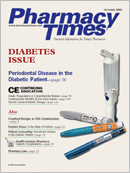Publication
Article
Pharmacy Times
Shake Well Before Dispensing
Author(s):
Obviously, it is important to ensurethat the active ingredient(s) in a suspensionis (are) properly dispersedthroughout the vehicle before administration."Shake well before use" is acommon reminder (in the form ofdirections typed on the pharmacylabel, an auxiliary label, or verbalinstructions) given by pharmacists topatients who receive oral suspensions.Yet, how often is this importantreminder forgotten by pharmacy staffmembers when preparing a smallerquantity of a suspension from a largestock bottle? What happens if thestock bottle is not shaken or is inadequatelyshaken?
One mother knows all too well. In areport to the Institute for Safe MedicationPractices, she explained that herson had been diagnosed with epilepsy,and his seizures were well controlledwith carbamazepine (Tegretol) oral suspension.His prescription called for 8 ozof carbamazepine to be dispensed witheach refill. Because the medication isavailable in a 16-oz stock bottle, smallerbottles were prepared for each refill.
Several days after starting a new bottle,the son had a recurrence ofseizures that lasted about a week. Duringthis time, his mother noticed thatthe suspension had a different appearancefrom the previous prescription.She mentioned this difference to theprescribing physician, who recommendedgetting a new refill. She wassubsequently more aware of theappearance of the suspension whenevershe had the medication refilled.Whenever the suspension looked differentfrom what was expected, shewould ask the pharmacist for areplacement, dispensed from anunopened manufacturer's bottle andshaken in her presence.
After a few of these occurrences,however, she insisted that the pediatricianwrite prescriptions instructingpharmacists to dispense the medicationonly in the 16-oz unopened manufacturer'sstock bottle. She saved severalof the more suspicious-lookingsuspensions dispensed in 8-oz bottlesand sent them to the manufacturer.Assays performed by the manufacturer'sQuality Control Division revealedthat 3 of the bottles contained suspensionsthat were significantly less concentratedthan the expected 100-mg/5-mL concentration, and 1 bottleof suspension was 3 times more concentratedthan was expected!
The problem appears to havestemmed from pharmacy staff membersnot shaking or inadequately shakingthe stock bottle of carbamazepinesuspension before preparing the smallerbottle. If an unopened stock bottleof a suspension was inadequatelyshaken before preparing a smaller bottle,the suspension that was pouredout could potentially be less concentratedthan expected. The remainderof the stock suspension would then bemore highly concentrated. Both situationscould potentially lead to significantvariability in doses, which couldaffect disease control (ie, recurrence ofseizures resulting from the less-concentratedcarbamazepine suspensiondispensed). This variability is particularlysignificant for drugs with a narrowtherapeutic index. Even if the suspensionis adequately shaken prior todispensing, if patients do not shakethe medication properly, similar variabilityin doses can occur.
In order to prevent such problems,pharmacy staff members should besure to adequately shake all suspensions.Education may be required forpharmacy technicians and students,who may not be aware of the differencebetween a solution and a suspension.Visually check that the suspensionis uniformly dispersed before it istransferred from its original container.Pharmacists involved in the finalcheck of a suspension should verifywith the individual who prepared itthat this important step was performedbefore allowing the suspensionto be dispensed.
Consider making auxiliary labels asreminders for pharmacy staff members thatread "Shake well before dispensing," and addthem to appropriate pharmacy stock bottles. Inaddition, attention could be drawn to suspensionsby highlighting or circling the word "suspension" on product labels. Make sure thatpatients receiving suspension preparations arecounseled so that they fully understand theneed to shake the medication well before eachuse. The "Shake Well" auxiliary label, whichcommonly accompanies the pharmacy label onsuspension preparations being dispensed, couldeasily be overlooked. It should not be used asthe only means of communicating this importantinformation, but rather it should serve as areminder for patients.
Dr. Kelly is the editor of ISMP MedicationSafety Alert! Community/AmbulatoryCare Edition.
Report MedicationErrors
The reports described here were receivedthrough the USP Medication Errors ReportingProgram, which is presented in cooperationwith the Institute for Safe Medication Practices(ISMP). ISMP is a nonprofit organizationwhose mission is to understand the causes ofmedication errors and to provide time-criticalerror-reduction strategies to the health carecommunity, policy makers, and the public.Throughout this series, the underlying systemcauses of medication errors will be presentedto help readers identify system changes thatcan strengthen the safety of their operation.
If you have encountered medicationerrors and would like to report them, youmay call ISMP at 800-324-5723 (800-FAILSAFE) or USP at 800-233-7767 (800-23-ERROR). ISMP's Web address is www.ismp.org.
Subscribe toNewsletter
Pharmacy Times and the Institute for SafeMedication Practices (ISMP) would like to makecommunity pharmacy practitioners aware of apublication that is available.
The ISMP Medication Safety Alert! Community/Ambulatory Care Edition is a monthly compilationof medication-related incidents, error-preventionrecommendations, news, and editorial contentdesigned to inform and alert community pharmacypractitioners to potentially hazardous situationsthat may affect patient safety. Individual subscriptionprices are $45 per year for 12 monthlyissues. Discounts are available for organizationswith multiple pharmacy sites. This newsletter isdelivered electronically. For more information,contact ISMP at 215-947-7797, or send an e-mailmessage to community@ismp.org.







